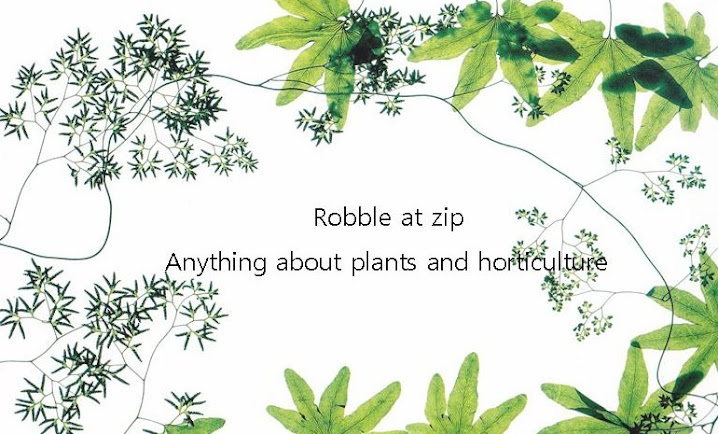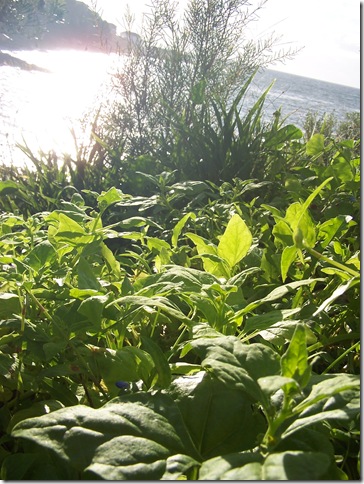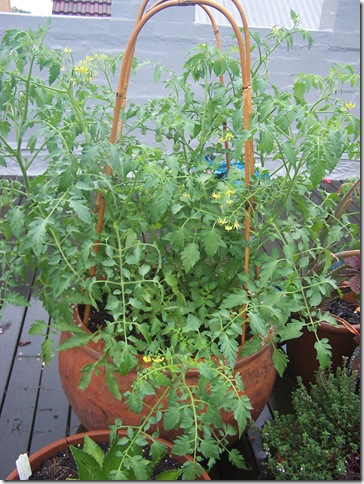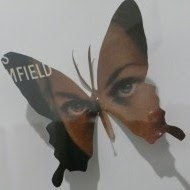Monday, February 22, 2010
I'm moving to Tumblr.com 23rd February, 2010
Im moving to tumblr.com. Please follow me here as I wont be doing any more posts on blogspot.
robbleatzip.tumblr.com
Thanks for your continued support,
regards
robble at zip
Wednesday, February 17, 2010
Warrigal Greens
Lately I have been walking around the cliffs between Coogee and Clovelly . I noticed a common ground cover that I couldn’t identify at first. It’s Tetragonia tetragoniodes, common name Warrigal Greens. It grows in moist areas close to the coast and estuaries.  The leaves of this plant are edible and were eaten by Aboriginals and early settlers. It needs to be boiled before eating to reduce the oxalate, which is poisonous.
The leaves of this plant are edible and were eaten by Aboriginals and early settlers. It needs to be boiled before eating to reduce the oxalate, which is poisonous.
“ The leaves are edible although bitter unless cooked. Captain Cook served them boiled daily to his crew and Joseph Banks thought they “eat as well, or very nearly as well, as Spinach”. Nowadays they are mainly enjoyed by native rats and other herbivores “– from Field Guide to The Native Plants of Sydney by Les Robinson
 Joseph Banks – Botanist and Explorer
Joseph Banks – Botanist and Explorer
What a fall from grace this vegetable has had! It sustained the early settlers and is now mostly enjoyed by rats.
On my bookshelf…………………..
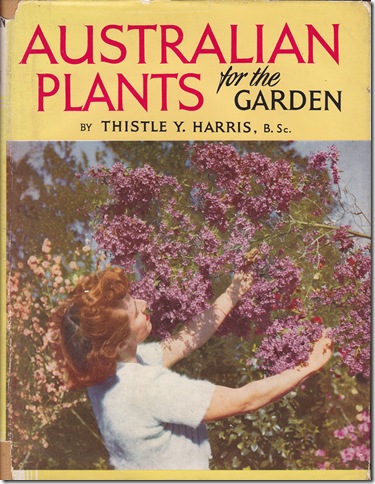 I’ve recently started studying Horticulture Certificate 4 by correspondence. This has led me to search through a lot of gardening books on my shelves. I found this gem of a book. It was given to me by a work colleague and I’d forgotten how great the illustrations are.
I’ve recently started studying Horticulture Certificate 4 by correspondence. This has led me to search through a lot of gardening books on my shelves. I found this gem of a book. It was given to me by a work colleague and I’d forgotten how great the illustrations are.
 |  |
It was published in 1953. I’ve found a few old newspaper clippings between the pages. “Gardening Without Tears, by Reg Edwards” and a recipe for prawn cocktails. I particularly love the 1950’s colour in the plates.
Friday, February 12, 2010
St Andrews Cross Spiders
The rain is still bucketing down here in Sydney. For me (and many others) its a welcome change. All of my pots are soaked and I have been moving some of cacti and succulents undercover to stop them from rotting out. Ive noticed some new insect arrivals: St Andrews Cross Spiders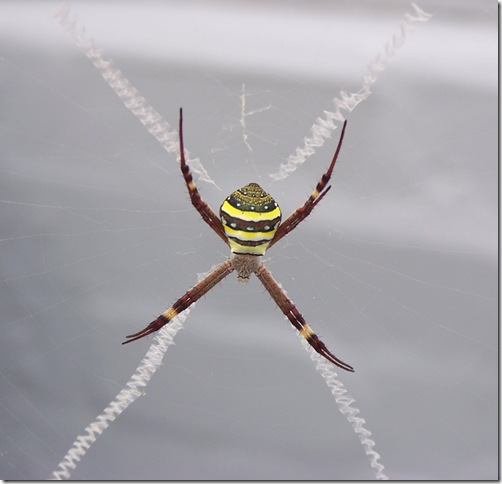 They are so called because of the silky cross at the centre of their web. This is called a stabilimentum. At first thought to stabilise the web, it is currently thought to either help capture prey or avoid predators.
They are so called because of the silky cross at the centre of their web. This is called a stabilimentum. At first thought to stabilise the web, it is currently thought to either help capture prey or avoid predators.
EDIT: Today, 17th February, I was standing on the balcony, brushing my teeth and a wattle bird landed on a nearby branch and ate the above spider, right in front of me. C’est la vie!

Tuesday, February 9, 2010
Rain – and little yellow mushrooms……….
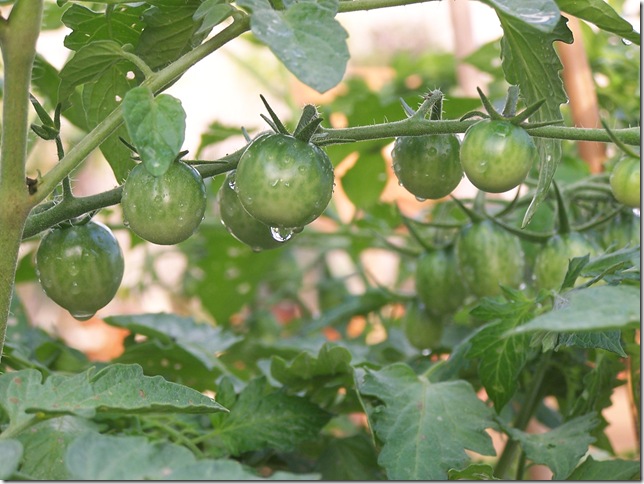
We’ve been having lots and lots of rain lately. I moved my pots out to catch it. I think theres no substitute for rainwater. I have also been indulging in my somewhat obsessive habit of collecting rainwater. As I cant have a rainwater tank, I now have lots of containers of rainwater, which are fast filling up with lots of mosquito larvae. I might have to move my new fishes around a bit!
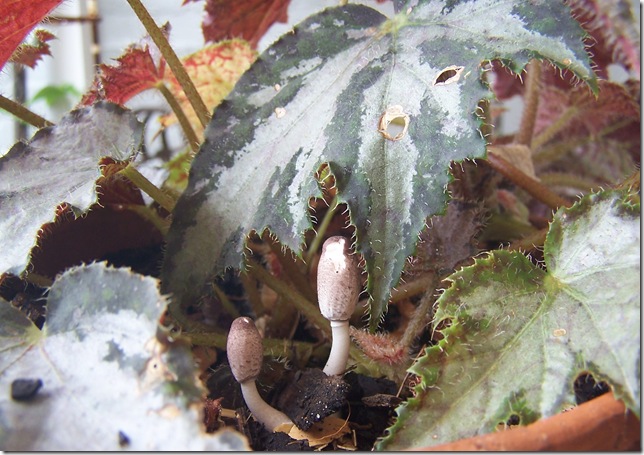 I’ve also noticed lots of mushrooms coming up in the pots. I checked, they are common and pretty harmless, although I’m not planning to eat them
I’ve also noticed lots of mushrooms coming up in the pots. I checked, they are common and pretty harmless, although I’m not planning to eat them | 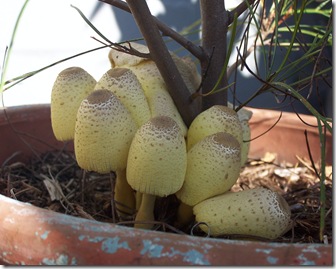 |
Friday, February 5, 2010
Blue Banded Bees
After a very mixed week, I was thrilled to find these critters buzzing around on my verandah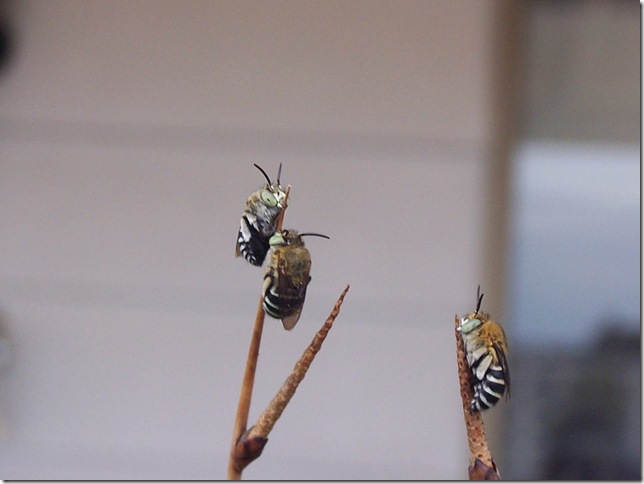 They are called Blue Banded Bees or Amegilla sp. and are native to Australia. They are, at the moment, all huddled on the tips of Lepiromia articulata which is in my watergarden. Its been pouring with rain for 2 days and they are all soaked
They are called Blue Banded Bees or Amegilla sp. and are native to Australia. They are, at the moment, all huddled on the tips of Lepiromia articulata which is in my watergarden. Its been pouring with rain for 2 days and they are all soaked
